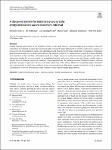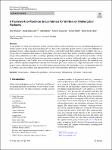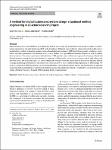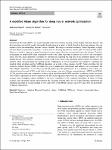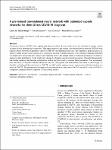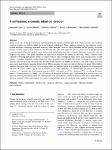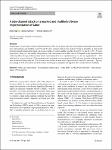Author
- Jorgensen, Ed (3)
- McFadyen, Ron (3)
- Nora, El-Rashidy (3)
- Christian, Homeyer (2)
- next >
Subject
- LCS (2)
- MIPS (2)
- mạng máy tính (2)
- programmer (2)
- < previous next >
Date issued
- 2020 - 2025 (293)
- 2010 - 2019 (39)
- 2000 - 2009 (2)
- 1999 - 1999 (1)
Has File(s)
- true (335)
OER - Công nghệ thông tin (335)
Bộ sưu tập tài liệu học liệu mở chuyên ngành Công nghệ thông tin: Lập trình, dữ liệu, hệ thống, database...
Item Title - Ascending [/1]
The fast improvement of deep learning methods resulted in breakthroughs in image classification, however, these models are sensitive to adversarial perturbations, which can cause serious problems. Adversarial attacks try to change the model output by adding noise to the input, in our research we propose a combined defense method against it. Two defense approaches have been evolved in the literature, one robustizes the attacked model for higher accuracy, and the other approach detects the adversarial examples. Only very few papers discuss both approaches, thus our aim was to combine them to obtain a more robust model and to examine the combination, in particular the filtering capabilit... |
Bayesian approaches to legal reasoning propose causal models of the relation between evidence, the credibility of evidence, and ultimate hypotheses, or verdicts. They assume that legal reasoning is the process whereby one infers the posterior probability of a verdict based on observed evidence, or facts. In practice, legal reasoning does not operate quite that way. Legal reasoning is also an attempt at inferring applicable rules derived from legal precedents or statutes based on the facts at hand. To make such an inference, legal reasoning follows syllogistic logic and first order transitivity. |
"A Byte of Python" is a free book on programming using the Python language. It serves as a tutorial or guide to the Python language for a beginner audience. If all you know about computers is how to save text files, then this is the book for you. |
Aiming at solving the problems of low success rate and weak robustness of object tracking algorithms based on siamese network in complex scenes with occlusion, deformation, and rotation, a siamese network object tracking algorithm with attention network and adaptive loss function (SiamANAL) is proposed. Firstly, the multi-layer feature fusion module for template branch (MFFMT) and the multi-layer feature fusion module for search branch (MFFMS) are designed. The modified convolutional neural networks (CNN) are used for feature extraction through the fusion module to solve the problem of features loss caused by too deep network. |
Recent technologies advancements promise to change our lives dramatically in the near future. A new different living society is progressively emerging, witnessed from the conception of novel digital ecosystems, where humans are expected to share their own spaces and habits with machines. Humanoid robots are more and more being developed and provided with enriched functionalities; however, they are still lacking in many ways. One important goal in this sense is to enrich their cognitive capabilities, to make them more “intelligent” in order to better support humans in both daily and special activities. |
Difficulty in emotion expression and recognition is typical of the personality trait known as alexithymia, which is often observed in persons with neurodevelopmental disorders (NDD). Past research has investigated various forms of conversational technology for people with NDD, but only a few studies have explored the use of conversational agents to reduce alexithymia. This paper presents Emoty, a speech-based conversational agent designed for people with NDD to train emotional communication skills. |
Finding relevant publications in the scientific domain can be quite tedious: Accessing large-scale document collections often means to formulate an initial keyword-based query followed by many refinements to retrieve a sufficiently complete, yet manageable set of documents to satisfy one’s information need. Since keyword-based search limits researchers to formulating their information needs as a set of unconnected keywords, retrieval systems try to guess each user’s intent. In contrast, distilling short narratives of the searchers’ information needs into simple, yet precise entity-interaction graph patterns provides all information needed for a precise search. |
Swarm intelligence leverages collective behaviours emerging from interaction and activity of several “simple” agents to solve problems in various environments. One problem of interest in large swarms featuring a variety of sub-goals is swarm clustering, where the individuals of a swarm are assigned or choose to belong to zero or more groups, also called clusters. In this work, we address the sensing-based swarm clustering problem, where clusters are defined based on both the values sensed from the environment and the spatial distribution of the values and the agents. |
As the number of online labor platforms and the diversity of jobs on these platforms increase, ensuring group fairness for workers needs to be the focus of job-matching services. Risk of discrimination against workers occurs in two different job-matching services: when someone is looking for a job (i.e., a job seeker) and when someone wants to deploy jobs (i.e., a job provider). To maximize their chances of getting hired, job seekers submit their profiles on different platforms. Similarly, job providers publish their job offers on multiple platforms with the goal of reaching a wide and diverse workforce. In this paper, we propose a theoretical framework to maximize group fairness for ... |
Since its emergence in the 1960s, Artificial Intelligence (AI) has grown to conquer many technology products and their fields of application. Machine learning, as a major part of the current AI solutions, can learn from the data and through experience to reach high performance on various tasks. This growing success of AI algorithms has led to a need for interpretability to understand opaque models such as deep neural networks. Various requirements have been raised from different domains, together with numerous tools to debug, justify outcomes, and establish the safety, fairness and reliability of the models. |
Domain Adaptation (DA) is a technique that aims at extracting information from a labeled remote sensing image to allow classifying a different image obtained by the same sensor but at a different geographical location. This is a very complex problem from the computational point of view, specially due to the very high-resolution of multispectral images. TCANet is a deep learning neural network for DA classification problems that has been proven as very accurate for solving them. TCANet consists of several stages based on the application of convolutional filters obtained through Transfer Component Analysis (TCA) computed over the input images. |
Digital business ecosystem (DBE) is a paradigm that enables developing and monitoring novel business models of collaborating organisations and individuals using ICT as the foundation. Different from traditional online networked models such as manufacturer, retailer, or franchise centred, using a shared digital environment, DBE fosters heterogeneity, symbiosis, coevolution, and self-organisation of its multiple actors, which enables it to span different business domains as well as exhibits diverse interests. For many organisations and individuals, DBE presents a new collaborative approach to leverage offered and desired resources among the involved members to meet each of their goals.<... |
We propose a novel minimal solver for sphere fitting via its 2D central projection, i.e., a special ellipse. The input of the presented algorithm consists of contour points detected in a camera image. General ellipse fitting problems require five contour points. However, taking advantage of the isotropic spherical target, three points are enough to define the tangent cone parameters of the sphere. This yields the sought ellipse parameters. Similarly, the sphere center can be estimated from the cone if the radius is known. These proposed geometric methods are rapid, numerically stable, and easy to implement. Experimental results—on synthetic, photorealistic, and real images—showcase th... |
Deep Neural Networks (DNNs) are widely regarded as the most effective learning tool for dealing with large datasets, and they have been successfully used in thousands of applications in a variety of fields. Based on these large datasets, they are trained to learn the relationships between various variables. The adaptive moment estimation (Adam) algorithm, a highly efficient adaptive optimization algorithm, is widely used as a learning algorithm in various fields for training DNN models. However, it needs to improve its generalization performance, especially when training with large-scale datasets. Therefore, in this paper, we propose HN Adam, a modified version of the Adam Algorithm, ... |
In this study, we propose a new genetic algorithm that uses a statistical-based chromosome replacement strategy determined by the empirical distribution of the objective function values. The proposed genetic algorithm is further used in the training process of a multiplicative neuron model artificial neural network. The objective function value for the genetic algorithm is the root mean square error of the multiplicative neuron model artificial neural network prediction. This combination of methods is proposed for a particular type of problems, that is, time-series prediction. |
Microbiome is closely related to many major human diseases, but it is generally analyzed by the traditional statistical methods such as principal component analysis, principal coordinate analysis, etc. These methods have shortcomings and do not consider the characteristics of the microbiome data itself (i.e., the “probability distribution” of microbiome). A new method based on probabilistic topic model was proposed to mine the information of gut microbiome in this paper, taking gut microbiome of type 2 diabetes patients and healthy subjects as an example. Firstly, different weights were assigned to different microbiome according to the degree of correlation between different microbiom... |
Coronavirus disease (COVID-19) is rapidly spreading worldwide. Recent studies show that radiological images contain accurate data for detecting the coronavirus. This paper proposes a pre-trained convolutional neural network (VGG16) with Capsule Neural Networks (CapsNet) to detect COVID-19 with unbalanced data sets. The CapsNet is proposed due to its ability to define features such as perspective, orientation, and size. Synthetic Minority Over-sampling Technique (SMOTE) was employed to ensure that new samples were generated close to the sample center, avoiding the production of outliers or changes in data distribution. |
In this work, we study resolvent splitting algorithms for solving composite monotone inclusion problems. The objective of these general problems is finding a zero in the sum of maximally monotone operators composed with linear operators. Our main contribution is establishing the first primal-dual splitting algorithm for composite monotone inclusions with minimal lifting. Specifically, the proposed scheme reduces the dimension of the product space where the underlying fixed point operator is defined, in comparison to other algorithms, without requiring additional evaluations of the resolvent operators. We prove the convergence of this new algorithm and analyze its performance in a prob... |
Infant cry is one of the first distinctive and informative life signals observed after birth. Neonatologists and automatic assistive systems can analyse infant cry to early-detect pathologies. These analyses extensively use reference expert-curated databases containing annotated infant-cry audio samples. However, these databases are not publicly accessible because of their sensitive data. Moreover, the recorded data can under-represent specific phenomena or the operational conditions required by other medical teams. Additionally, building these databases requires significant investments that few hospitals can afford. This paper describes an open-source workflow for infant-cry detectio... |
In this paper, we show that a software implementation of IND-CCA-secure Saber key encapsulation mechanism protected by first-order masking and shuffling can be broken by deep learning-based power analysis. Using an ensemble of deep neural networks trained at the profiling stage, we can recover the session key and the secret key from 257×N and 24×257×N traces, respectively, where N is the number of repetitions of the same easurement. The value of N depends on the implementation of the algorithm, the type of device under attack, environmental factors, acquisition noise, etc.; in our experiments N=10 is sufficient for a successful attack. The neural networks are trained on a combination ... |






